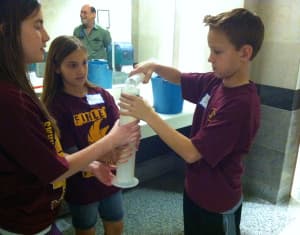AMWUA Blog
BY: Warren TenneyStudents Learn Conservation, Math And A Little Plumbing

Twenty-five sixth graders did a little plumbing for the Town of Gilbert last month. Drew Goodman and his classmates installed 42 aerators on faucets in 11 bathrooms inside the town's Court and Fire Administration buildings. Drew was surprised at how much water could be saved by simply changing a traditional faucet aerator to one that slows the flow. "We could save millions of gallons," Drew said after doing the math.
The Finley Farms Elementary School students were participating in a program from the University of Arizona's Project WET (Water Education for Teachers). The program uses math and science to encourage students to think about the water they use, where it comes from and how to conserve it. The program, called Water Scene Investigations, includes lessons on how to use a pair of pliers, install a water-efficient aerator, and measure and calculate the amount of water an aerator saves each day, week and month.
Support from Gilbert and the City of Chandler means 45 classrooms of sixth graders will participate in Arizona Project WET’s Water Scene Investigation program this year. That’s nearly double the number of classrooms that participated last year. During the last two years, the Town of Gilbert has invested money, faucet aerators, people and time to bring the program into its schools. Here is a brief description of the Water Scene Investigation program.

Finley Farm Elementary students do a little math with guidance from one of Gilbert's Conservation Specialists.
- In the classroom, a Project WET instructor teaches students about the water they drink, water-saving technologies and how to install a faucet aerator.
- Each student receives at least one water-efficient aerator to install at home. For homework, students estimate the amount of water used daily in their home’s bathroom sink. The student is assigned to measure the volume of water that flows from the bathroom faucet in five-second intervals with a traditional aerator and without an aerator. Then the student installs a water-efficient aerator and measures again.
- The math happens, followed by the ah-ha moment. Students determine the amount of water saved in a week, a month and a year by installing an aerator on one faucet. They see that one simple change adds up to a lot of savings. (Project WET hopes this is a teaching moment for everyone in the family.)
In this case, the Finley Farms students enjoyed a bonus field trip to install the aerators in two municipal buildings and calculate the savings. This gave the students an opportunity to provide community service (and do a bit more math) and gave the town an additional return on its investment. The aerators the students installed reduced each faucet’s flow from 2.2 gallons per minute to 0.5 gallon per minute and will save the town about 45,000 gallons of water a year. Last year, students from Gilbert’s Settler’s Point Elementary also installed water-efficient aerators in the bathrooms of two additional Gilbert municipal buildings saving the town more than 100,000 gallons a year.
Finley Farms student plumber Paige Dahman said she was surprised to learn from Project WET that Earth is made up of more water than land, but cautioned that we still have to worry about water to drink.
“We have to keep it clean and make sure we have enough for everybody,” Paige said.
Arizona Project WET’s other programs include teacher training , water festivals , and field trips to local wetlands . Arizona Project WET helped to pilot the national Project WET program in 1989. Since then, more than 785,000 Arizona students and 14,000 teachers have participated in its programs, made possible with help from 2,239 volunteers. Educating elementary school students about water gives them a foundation to appreciate and understand how important water is throughout their lives.
For 46 years, Arizona Municipal Water Users Association has worked to protect our member cities’ ability to provide assured, safe and sustainable water supplies to their communities. For more water information visit www.amwua.org .
